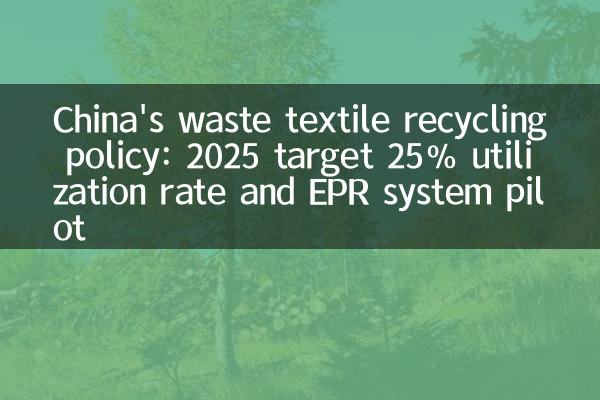China's waste textile recycling policy: 2025 target 25% utilization rate and EPR system pilot
In recent years, with the deepening of the global sustainable development concept, China has also accelerated its policy layout in the field of recycling waste textiles. According to the latest "Implementation Opinions on Accelerating the Recycling of Waste Textiles", by 2025, China's waste textile recycling rate will reach 25%, and the Extension of Producer Responsibility (EPR) system will be piloted in key areas. The introduction of this policy marks an important step in China's green transformation in the textile industry.
1. Policy background and goals

China is the world's largest textile producer and consumer, producing more than 20 million tons of waste textiles each year, but the recycling rate is less than 10%. A large number of waste textiles are landfilled or incinerated, which not only causes waste of resources, but also aggravates environmental pollution. To this end, the Chinese government has set clear recycling goals and plans to promote industry changes through policy guidance and market mechanisms.
| index | Current Situation in 2020 | 2025 goals |
|---|---|---|
| Annual production of waste textiles | 20 million tons | It is expected to grow to 25 million tons |
| Recycling rate | Less than 10% | 25% |
| Annual utilization of recycled fibers | About 2 million tons | It reaches 4 million tons |
2. EPR system pilot: Promote the implementation of producer responsibilities
The Extended Producer Responsibility (EPR) system is one of the core contents of this policy. This system requires textile and garment companies to be responsible for the entire life cycle of their products, including recycling, processing and reuse. At present, the pilot work has been carried out in Zhejiang, Guangdong, Jiangsu and other places, focusing on fast fashion brands and large-scale clothing companies.
| Pilot areas | Key enterprises | Main measures |
|---|---|---|
| Zhejiang Province | Semir, Peacebird | Establish an offline recycling station and explore the "old trade-in" model |
| Guangdong Province | Xiyin (SHEIN), UR | Implement digital recycling systems to encourage consumers to participate |
| Jiangsu Province | HaiLan Home | Join recycled fiber enterprises to create a closed-loop supply chain |
3. Industry challenges and opportunities
Although the policy provides a clear direction for recycling waste textiles, the industry still faces many challenges:
1.Technical bottlenecks:At present, domestic recycled fiber technology is still mainly based on physical recycling, and chemical recycling technology has not yet been applied on a large scale, resulting in a low proportion of high-value utilization.
2.The recycling system is incomplete:Residents lack awareness of garbage classification and the limited number of professional recycling companies has restricted the improvement of recycling rates.
3.Cost issues:The production cost of recycled fibers is 20%-30% higher than that of native fibers, and the market competitiveness is weak.
At the same time, policies have also brought new market opportunities. It is predicted that by 2025, the scale of China's waste textile recycling industry will exceed 50 billion yuan, driving more than 100,000 jobs.
4. References to international experience
European and American countries have formed a mature model in the field of waste textile recycling. For example, the EU requires member countries to achieve full coverage of textile classification collection by 2025, and France has passed legislation to mandate companies to fund recycling projects. China's EPR pilot also draws on some international experience, but needs to be adjusted in combination with the characteristics of the local market.
| Country/Region | Recovery rate | Core Policy |
|---|---|---|
| EU | About 50% | Classified collection mandatory and ecological tax collection |
| Japan | 35% | Joint enterprise recycling system and consumer return reward |
| USA | 15% | Leading by non-profit organizations and voluntarily participating by brand owners |
5. Future Outlook
With the implementation of policies and the growth of market demand, China's waste textile recycling industry will usher in a period of rapid development. In the next step, the government may introduce fiscal and tax preferential measures to encourage enterprises to increase investment in technology research and development. Consumer education will also become the focus, and public participation will be enhanced through public welfare publicity. To achieve the 25% utilization target, all links of the industrial chain need to work together to jointly build a new green and low-carbon textile economy system.
(The full text is about 1,000 words)

check the details

check the details